Shogun: Total War Warlord Edition Preview
Fierce Mongol hordes invade Japan in the new, expanded edition of the award-winning Shogun: Total War.
Shogun: Total War stands out as one of the more critically acclaimed games of 2000. It was nominated for and won a number of strategy game awards, and GameSpot named it the 2000 Strategy Game of the Year. Shogun blends thoughtful turn-based strategy with challenging real-time combat on a grand scale, all presented with a refined sense of style and high production values. Building on its success with Shogun, developer Creative Assembly is rereleasing the game as the Warlord Edition. This new edition features both an enhanced version of the original game and all-new material known as The Mongol Invasion. (The Mongol Invasion should also be available separately through publisher EA's online store to gamers who already own Shogun.) The Warlord Edition will feature a host of additions and enhancements, including new units, scenarios, campaigns, and a map editor.
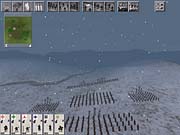
One of Shogun's more unusual and successful elements is its smooth integration of a turn-based strategy game with real-time tactical combat. The turn-based element looks and plays a lot like a traditional strategy board game, in which you send your clan's armies, emissaries, spies, and ninja assassins to neighboring Japanese provinces in the hopes of exploiting or conquering them. The relatively unglamorous yet fun strategic elements of empire building, like dealing with resources in the form of rice, are reserved for this contemplative turn-based portion of the game. When armies clash, you can let the computer handle the battles for you, or you can switch over to appropriately dramatic real-time combat on a 3D battlefield and lead your troops directly. Here, you'll command your armies in massive battles, which sometimes feature thousands of troops. It's a logical and pleasing division of strategic and tactical elements that sets Shogun apart from many strategy games that try to handle both elements through either a slow turn-based design or manic real-time gameplay.
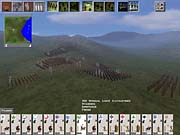
The original Shogun game plays out in Japan's bloody 16th century, known as the Sengoku Jidai, or Warring States period. With a weak emperor on the throne, rival clan warlords known as Daimyo had struggled to accumulate power in battle after battle. This exotic and brutal period provides the backdrop for a game that's very colorful yet rooted in history. To ensure historical accuracy, the designers have consulted with Dr. Stephen Turnbull, an expert on the period.
The new, additional material in the Warlord Edition takes you back to another dramatic period in Japan's history. In 1274, the great Mongol warlord Kublai Khan dispatched his forces to Japan's southernmost main island of Kyushu in the hopes of conquest. The Mongols were beaten back by the Japanese, but that didn't stop the invaders from trying again in 1281. This time, Kublai Khan's fleet was obliterated by a massive typhoon, called the "kamikaze," or divine wind. The Shogun Warlord Edition puts you in the boots of the Mongol invader and Japanese defender. Where the original game focuses on building up and cultivating the land in your efforts to control it, the new material will offer an alternative style of gameplay. Here, the Mongols will concentrate on destruction, pure and simple.
New Features
The planned inclusion of 10 new battlefield units in the Warlord Edition should add to your tactical options during the real-time battles. The battlefield ninja will be able to hide in almost any terrain and use short-range projectile weapons for sneak attacks on powerful generals. The Mongols will have Korean "thunder bomber" troops at their disposal. These special soldiers employ primitive grenades made from gunpowder-filled flasks. New too will be the Korean skirmishers, which are lightly armed javelin-throwing soldiers used to screen formations of heavier troops. Of course, the famed and feared Mongolian cavalry will make its appearance, putting even the bravest Japanese samurai to the test. New upgrades, like the drill dojo, should act as welcome means of improving generals' abilities.
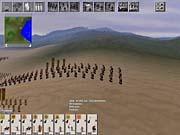
The Warlord Edition will offer numerous play options. The full campaign has four difficulty levels--this is the turn-based/real-time style of gameplay that lets you select from four different goals to win. Take all the provinces of Japan, gain control of 40 of 60 regions, eliminate all rival clans, or keep your clan alive for 70 years. The custom battle option lets you create a hypothetical engagement during either the Sengoku Jidai or Mongolian invasion periods. You can appoint the attackers and defenders and select the season, difficulty level, and time limit, if any. You can choose from a list of 112 varied maps, featuring different types of terrain and castles. If that's not enough, a new, easily learned point-and-click map editor will let you create your own battlefields. Multiplayer options will be expanded to let you play both individual battles and the full strategy campaign game via the Internet or a LAN.
If you'd like to test your mettle in a historical battle, you'll be able to do that too. There should be at least nine battles that pit Japanese, Mongols, and Koreans against each other, and you'll get to assume the mantle of famous warlords such as Oda Nobunaga and Tokugawa Ieyasu. That's also true of the tentative four multibattle historical campaigns that will ship with the Warlord Edition. Each one will center on a famous conqueror, including Oda Nobunaga, Tokugawa Ieyasu, and Toyotomi Hideoshi. One campaign will let you play as Kublai Khan, letting you rewrite history in favor of the Mongols. This campaign shows what might have happened had the Mongols bolstered their vanguard invasion force with reserves and Korean auxiliary troops after landing at Hakata Bay.
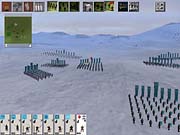
Once on the battlefield, you'll likely find that the basics of combat are easy to learn, since the military units essentially engage each other according to a rock-paper-scissors scheme. Readied spearmen defeat onrushing cavalry, mounted warriors easily overrun archers at close ranges, and archers defeat slow-moving spearmen. Unlike many real-time strategy games that work on this sort of principle, battles in Shogun remain complex and challenging because of a host of other factors that enter into combat. Terrain and weather, for instance, can be turned to your advantage. Bowmen firing downhill at fatigued troops struggling to advance up a steep slope will quickly gain the upper hand. You can hide troops in forests as a reserve force or order them to spill out onto the plains in a deadly ambush.
Units are composed of dozens of similar soldier types, like cavalry archers or spearmen. You issue basic unit orders, like advancing or attacking through a simple point-and-click interface. More complex options are available by right-clicking a unit's battle standard. From a pop-up menu (or hotkeys), you can assign aggression stances and formations, like a wedge for breaking enemy lines or a loose formation to spread out troops coming under arrow fire. Multiple units can be grouped together and then issued more numerous and complex formations. It's an intuitive system, though at this stage, reorienting unit facings is still a bit awkward.
The Art of Total War
One of the unusual features of Shogun is its reliance on Sun Tzu, the ancient Chinese sage whose observations on strategy for both war and life were collected under the title The Art of War. Sun Tzu claimed that "to win without fighting is best," and he emphasized Taoist-like principles of restraint, patience, subtlety, and deception over brute force. For Sun Tzu, a leader's goal is to get the enemy to defeat himself. Chinese thought has played a major role in Japan's philosophical development, so it seems fitting that the designers of Shogun would turn to Sun Tzu for inspiration. The artificial intelligence in the game uses more than 250 rules derived from the Art of War to ensure behavior that's both realistic and unpredictable. The Warlord Edition should include AI improvements in the strategic game, too, with Daimyo adopting more complex diplomatic strategies, for instance.
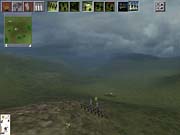
One of Shogun's great strengths is its presentation--not just the in-game graphics. The menus unfold like wax-sealed paper messages. Behind them, against a blood-red background, silhouetted horsemen gallop by in what resemble intricate black paper cutouts. The cinematics are also a highlight. The opening scene, for instance, features a lone samurai taking graceful practice sword swings in a field of blowing grass. It's a stark, simple, yet elegant image that seems to draw from traditional Japanese aesthetic sensibilities.
Shogun's graphics are also notable for the magnificent way they capture Japan's rugged natural beauty. Snow-capped peaks tower over gloomy valleys, narrow paths wind through lush fields, and scattered pines cling to mountaintops above jagged cliffs. Undulating terrain, distant fog, and wispy clouds all create a powerful sense of place and contribute to the epic sweep of the game. New coastal terrain, scrub, and rocky outcroppings will make their appearance in the Warlord Edition to add even more diversity and visual refinement to the battlefields. Expect improved unit sprites to complement the beautiful terrain.
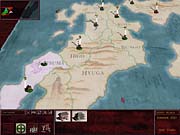
When you zoom the camera out, the imposing surroundings will dwarf your military units, and it's quite a sight when hundreds upon hundreds of soldiers march or gallop on horseback in formation. Battles often take on the monumental scope of film director Akira Kurosawa's legendary samurai epics. A fairly unobtrusive camera system should help you keep track of the action easily.
The original Shogun: Total War offered a welcome fusion of turn-based strategy and real-time tactics. Firmly rooted in history and elegantly presented, the game caught the imagination of many gamers and critics. The upcoming Warlord Edition--with its new units, new historical battles and campaigns, and other features and improvements--shows a strong chance of strengthening an already excellent game.
Got a news tip or want to contact us directly? Email news@gamespot.com
Join the conversation